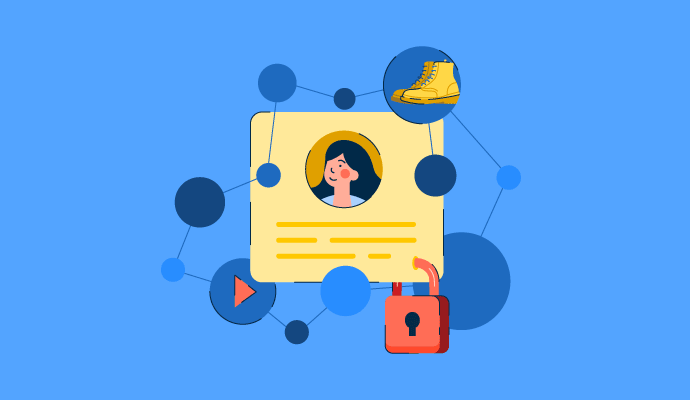February 24, 2020
 by Stephanie Graham / February 24, 2020
by Stephanie Graham / February 24, 2020

Every day, consumers are inundated with generic advertisements on billboards, subway ads, and TV and radio commercials.
While mass marketing can be useful for building brand awareness, this untargeted approach is less effective online. In digital spaces, consumers are accustomed to curating their push notifications, email inboxes, and social media feeds to ensure they only receive the content that interests them.
Think about the last advertisement or marketing message that impacted you enough to follow up on it. It probably wasn’t something generic, like that toothpaste ad you pass on your way to work every morning. Maybe it was a promotion code for those shoes you were thinking about buying last week, or a personalized thumbnail on Netflix suggesting you watch its original film Always Be My Maybe, based on your history of watching movies starring Keanu Reeves.
| Related: Learn seven push notification strategies to boost customer engagement → |
Today, personalized marketing experiences like these are common—and even expected by consumers. The best kind of advertisement is one that feels so natural, it makes the target audience convert without even thinking about it. At its core, personalization is about ensuring the content your customers see is relevant and interesting to them. Technology makes it possible for companies to gather all sorts of information about their customers, but in the process, it’s made consumers wary of how businesses use their personal data. The key to building exceptional customer experiences is understanding the balance between privacy and personalization.
Consumers make choices every day about where to spend their money, and they have a seemingly infinite supply of options. In an already saturated, hyper-personalized market, it’s difficult to build and sustain customer loyalty.
To stand out from the crowd and increase repeat customers, brands must provide exceptional brand experiences. According to a Salesforce survey of consumers and business buyers, 84% of customers say the experience a company provides is as important as its products or services. In short, customer engagement that is both conversational and highly tailored is the new standard. As it turns out, personalization is one of the best ways to provide exceptional customer experiences; a report from marketing company Epsilon found that 80% of consumers are more likely to purchase a product or service from a brand that offers personalized experiences.

Like account-based marketing, personalization has been around for a long time. However, its execution has dramatically evolved over the last decade. Advances in consumer technology and business software make it possible for even small and mid-market companies to develop hyperpersonalized marketing campaigns. And at the center of it all: customer data platform (CDP) software.
CDPs aggregate and unify customer data from many different sources (e.g., CRM, email marketing systems, social media, POS software, and offline sources) and allow businesses to leverage that data across marketing channels. As a marketer’s technology stack grows, so does their data. Each software solution collects valuable information about a customer’s interests and behaviors. But this information can quickly become siloed and spread across many different tools. What if you could bring all this information together to create a comprehensive, 360-degree view of your customers’ journeys? This is exactly what a CDP does, and it’s what helps marketers develop the highly personalized interactions their customers have come to expect.
While the core function of CDPs sounds simple, there is a growing industry of advanced solutions that provide additional capabilities such as identity resolution software and marketing automation software. Increasingly, CDPs are implementing artificial intelligence (AI) technology to enable true 1:1 personalization, optimizing the customer journey with predictive insights, smarter segmentation, and behavior-based messages. Emily Malis, G2 research principal for marketing and digital advertising, predicts these new AI-enabled capabilities will contribute to 45% growth in the CDP industry in 2020.
Gathering data is just the first step. After CDPs have consolidated customer data from disparate sources, personalization engines can leverage that data to help marketers create, test, and deliver personalized, omnichannel marketing campaigns throughout a customer’s journey.
We’ve established that consumers are more likely to increase their purchasing activity after viewing personalized content—studies even show that lack of personalization can drive customers away. Smart Insights reports that 74% of consumers said they feel frustrated when they’re fed irrelevant website content. The potential, and potentially significant, ROI that can be gained from personalization makes it an especially powerful tool for e-commerce businesses. The growth of e-commerce personalization can be seen on G2 as well; the category saw a 95% jump in reviews from 2018–2019.
While technological advancements make it possible for any business to leverage the power of personalization, the shift to digital has led to widespread concern about data breaches and consumer privacy. According to Salesforce, more than half of consumers are comfortable sharing their personal information as long as it’s used transparently and in ways that will benefit them. However, 72% of customers said they would stop purchasing a company’s products or services due to privacy concerns.

To avoid potential data scandals and negative perceptions, brands must understand what data they’re collecting and inform consumers how their data is being used. These statistics are a strong argument for companies to comply with new privacy laws, including the General Data Protection Regulation (GDPR) and the California Consumer Privacy Act (CCPA), but some businesses are lagging behind. In October 2019, data security company Egress reported that just over half of companies in the United States would not be fully compliant with CCPA by its effective date on Jan. 1, 2020.
For companies struggling to comply with privacy laws, personalization and all its implications of data security seem unattainable, leading to slower adoption of personalization technology. In a survey of 325 digital customer experience (DCX) executives, 79% said digital experience was an "extremely" or "very high" priority for their organization. Ironically, respondents indicated that one of the main challenges they faced was “fragmented customer data,” but almost half said they still hadn’t invested in personalization tools or had no budget in place for it.
| Learn more: The top privacy and security trends analysts anticipate in 2020 → |
If marketers wish to solve these problems in their organizations—unify their customer data, improve digital experiences for their customers, and practice good data security—they need to invest in the technology that makes personalization possible. Since CDPs maintain a persistent view of all customer data, they are a valuable asset for complying with privacy laws that mandate transparency and responsibility around data collection. At the same time, marketers must gain a comprehensive understanding of their customers and a powerful vehicle for delivering engaging, personalized, omnichannel marketing campaigns.
Fundamentally, marketing is about understanding the customer and their needs. This was true even before the internet, but advancements in technology have made it possible to understand customers on a more granular level than ever before. Although CDPs may be the foundation of true personalization, they aren’t the only personalized marketing tools. Small businesses—or startups with limited funds or an undefined marketing strategy—may be interested in testing the personalization waters but hesitant to invest in CDP software right away.
Fortunately, there’s more than one way to deliver hyper-targeted messages to your customers in the right place at the right time:
Although these solutions won’t provide the same 1:1 personalization afforded by a CDP, they do help businesses create more relevant or contextual experiences for their customers based on their location or past engagement. After implementing and testing point-based solutions, marketers can gain a better understanding of the strategies that generate ROI and assess the value of purchasing a CDP to upgrade their personalization campaigns.
Stephanie is a Market Research Manager and Senior Research Analyst at G2 concentrating on marketing and digital advertising software. Prior to joining G2, Stephanie spent four years in B2B marketing and event management at an independent publishing company. This experience nurtured her passion for understanding how technology can help solve the unique challenges small businesses face today. Stephanie’s areas of interest include brand perception, customer experience, SEO, and local marketing. She received her BA in journalism and Spanish from Marquette University and in her spare time enjoys reading, gaming, and trying new vegetarian restaurants.
The COVID-19 pandemic brought about changes to many industries, including one of the most...
 by Subhransu Sahu
by Subhransu Sahu
What is customer experience management? Customer experience management, or CXM, is how...
 by Holly Landis
by Holly Landis
One of the hottest topics in data privacy management in 2020 is automation—specifically,...
 by Merry Marwig, CIPP/US
by Merry Marwig, CIPP/US
The COVID-19 pandemic brought about changes to many industries, including one of the most...
 by Subhransu Sahu
by Subhransu Sahu
What is customer experience management? Customer experience management, or CXM, is how...
 by Holly Landis
by Holly Landis


